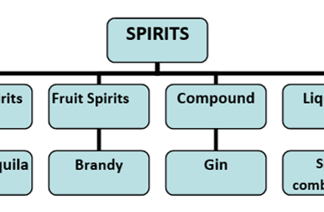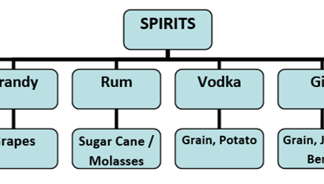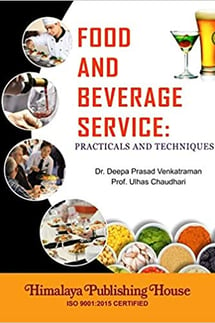Introduction and Classification of Spirits
10.1 Definition
10.2 Introduction
10.3 Forms of Spirits
10.4 Classification of Spirits
10.5 Calculation of alcohol content
Rationale
to study how spirits are made
to understand the types of various spirits
to learn how to measure alcoholic content with reference to proof spirit
10.1 Definition
The spirit is a fermented liquid of starch, sugar, water and base ingredients, which is usually a fruit, cereal, vegetable or molasses.
10.2 Introduction
The term spirit is often used synonymously with liquor. Spirit has higher alcohol content than beer and wines. The word proof refers to the alcohol content of a spirit and is derived from the Latin word probare, meaning to prove or test.
Spirits by federal government defines as any alcoholic beverage containing significant amount of distilled ethanol.
Spirits are distilled and unsweetened alcoholic beverages. They have high alcoholic percentage. The process of distillation of a fermented base product is used to produce them. It is so because distillation eliminates some of the congeners and concentrates the alcohol. For the production of spirits, the aim is to increase the alcohol content of the liquid.
Spirits can be added to wines to create fortified wines, such as port and sherry.
10.3 Forms of Spirits
Spirits are classified according to either their alcoholic source or their processing method. The five major groups of spirit are:
Table. 10.1 Types of Spirits
Spirits are made from grain includes whiskeys, vodka, grain neutral spirits, and compound liquors such as gin and Aquavit. Rum and tequila are the fruit liquors. Liqueurs and cordials are made from a base grain, plant, and fruit liquors or their combinations. Aromatic or fruit bitters are highly flavored spirits containing bitter substances such as quinine.
10.4 Classification of Spirits
Table 10.2 Types of spirits and its raw material used
Spirits Definitions
Vodka
Vodka is traditionally made from potatoes or fermented cereal grains. Some brands also make it from other ingredients like fruit or sugar. One of the most consumed and prefered alcoholic drink, vodka is either consumed neat or as cocktails like Martini, Bloody Mary and Cosmopolitan.
Whiskey
Whiskey is type of distilled alcoholic beverage, generally made from fermented grain mash including barley, corn, rye, and wheat. The distinctive taste of the drink is achieved after it is fermented in charred white oak wood. The aging process of whiskey stops once it is bottled from the casks. Up to 40% of alcohol is present in a good whiskey.
Brandy Although brandy can be made from any fruit but in order to achieve higher acidity it is traditionally made from early grapes. Generally an after dinner drink, brandy contains 35-60% alcohol. Unlike whiskey, brandy is aged either in wooden barrels or through caramel coloring.
Rum
Spirit made by using the byproducts of sugarcane or sugarcane juice directly and is then distilled. The liquid is then aged in barrels.
Gin
Gin gets it’s name from Juniper berries. It is made from juniper, coriander, citrus peel, cinnamon, almond or liquorice, with neutral grain alcohol. All the flavourings in the gin is natural.
Tequila
Tequila is a distilled alcoholic beverage made primarily in the area surrounding Tequila, a town in the western Mexican state of Jalisco. It is made from the agave plant (maguey) - a succulent, similar to the lily, which is native to Mexico.
Alcoholic Beverages
FERMENTED DISTILLED
WINE BEER MEAD PERRY CIDER
STILL LAGER
SPARKLING ALE SPIRITS COMPOUND
FORTIFIED PORTER WHISKEY LIQUEUR
AROMATIC STOUT BRANDY COCKTAILS
VODKA
GIN
TEQUILA
10.5 Calculation of alcohol content
Proof is defined as twice the alcohol (ethanol) content by volume. For example, a whisky with 50% alcohol is 100-proof whiskey. Anything 120-proof would contain 60% alcohol, and 80-proof means 40% of the liquid is alcohol.
The word proof came about in the 18th century when sailors, unloading their ships of cargo and whiskey, had only one way to tell the strength of the liquor they were carrying: they would mix a little bit of whiskey with a pinch of gunpowder and drop a lighted match into the mixture. If it ignited with an audible “proof”, the sailors knew at least half the content was alcohol.
Determining ABV
ABV is the basis for calculated alcohol proof, it is useful to know how alcohol by volume is determined.
There are two methods:
1. Measuring alcohol by volume
2. Measuring alcohol by mass.
The mass determination does not depend on temperature, but the more common percent (%) of total volume is temperature dependent. The International Organization of Legal Metrology (OIML) requires volume percent (v/v%) measurements be performed at 20 °C (68 °F).
Countries belonging to the European Union may measure ABV using either mass percent or volume percent.
The United States measures alcohol content in terms of alcohol percent by volume. The percentage of alcohol by volume must be labelled, although most liquors also state proof. Alcohol content may vary within 0.15% of ABV stated on the label, for spirits containing no solids and over 100 ml in volume.
Officially, Canada uses US labeling stating percent alcohol by volume, although the UK proof standard may still be seen and heard.
Common spirits at 40% ABV are called 70° proof, while 57% ABV is 100 proof. "Over-proof rum" is rum containing greater than 57% ABV or exceeding 100° UK proof.
Alcohol Proof Example:
· An alcoholic beverage that is 40% ethyl alcohol by volume is referred to as being '80 proof'.
· 100-proof whiskey is 50% alcohol by volume.
· 86-proof whiskey is 43% alcohol by volume.
· Pure alcohol or absolute alcohol is 200 proof.
Terms
Spirits
Grain
Gin
vodka
rum
whiskey
tequila
ABV
proof
beer
mead
perry
cider
liqureures


Introduction to Distilled Beverages
Beverages Service
Paperback
January 2020 Edition
Author:
Dr. Deepa Prasad Venkatraman
Ulhas Chaudhari
Food & Beverage Services Practical & Techniques
Paperback
January 2020 Edition
Author:
Dr. Deepa Prasad Venkatraman
Ulhas Chaudhari










